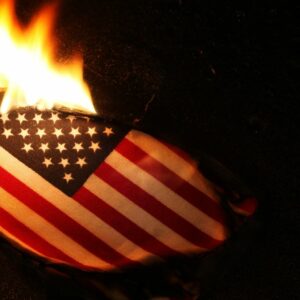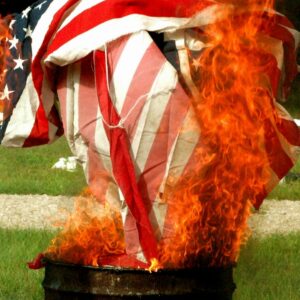What is Flag Burning all about?
Flag burning takes place when an American flag is deemed too marred and tattered to continue to fly. Never is it acceptable for an American flag to be thrown away, as this would be a sign of defeat for the message that it stands for. Instead, flag burning is deemed a more honorable option. The United States Military does everything that it can to take care of its flags, out of a deep seated respect for “the republic for which it stands.” Sometimes however, especially if it has been torn apart in a battle, it is simply unavoidable. When this happens, a flag burning service is held, giving the flag its last honor.

This flag burning service usually begins with the Pledge of Allegiance, followed by a reading of the poem, “I Am Old Glory,” which recounts all of the fateful moments and victories the American flag has witnessed. A moment of silence is usually next, as the crowd quietly considers the solemnity of the moment. Then the field of blue stars is carefully cut out of the flag, and placed on the fire. As the red and white stripes are added to the fire, the color guard says emphatically, “Our flag rests in peace!” The crowd departs then as the military band plays “Stars and Stripes Forever,” completing the flag burning service. This flag burning service combines solemnity with the joy and pride of being an American. While participants in the ceremony cannot help but feel a little sad over the demise of a flag, they take comfort in the fact that its message, and the nation that it represents will live on.
Some, outside of the military, have in the last few decades, extended the right to freedom of speech to mean a right to flag burning. This subject has sparked deep seated feelings on both sides, even among those who would never do it themselves. A clear distinction ought to be drawn between this form of flag burning, and the manner that the United States Military uses. Flag burning protestors often insist that they have respect for the principles endowed in the United States Constitution, but choose to burn the American flag to symbolize the ways that they believe that America has strayed from its original path. Opponents of this form of flag burning argue that this is counterproductive, and is really working against America itself.
In many other nations, flag burning in this way is illegal. Some nations, such as Norway, Austria, and Germany impose strict penalties on this form of flag burning, including heavy penalties, or even up to a year in prison. In an attempt to deter protest flag burning as a whole, Norway and Austria have also placed penalties on burning the flags of other nations as well. Other nations known to have a somewhat feistier relationship with the world, such as Egypt and Turkey, have allowed flag burning when it comes to enemy nations flags.
Military flag burning runs with a number of other traditions, designed to prevent the flag from being desecrated. For example, it is also a statute that the flag cannot be flown upside down. Nor should it ever be dropped to the ground, be made to dip, or be cut up and made into a costume. All of these preventions, along with flag burning, are a silent proclamation that the liberties endowed by the United States Constitution live on, safe and secure.

Flag burning is a tradition that dates back to America’s British roots, from a time well before 1776. Even today, flag burning is consistently applied by the British military as well, who like Americans do of their country, believe that the United Kingdom is the greatest country in the world, and wish to present a visible symbol of their country’s strength around the world as well.
Flag burning is also often applied in the German military as well, a policy implemented by Kaiser Wilhelm II.
It may come as a surprise that the original American flag, knit together by Betsy Ross, never had to be burned. Instead, after 233 years of life, it is still on display at the Smithsonian Institute, in Washington D.C. This well illustrates why many in the United States Military will do anything they can to avoid the prospect of flag burning, in the hopes that flags can be consistently well maintained over the years, and even centuries. Sometimes however, especially after a flag has been flown in a battle, that is not always possible.
There are two kinds of flag burning, one in protest and the other in respect. Protest flag burning is condemned by most countries, and arguably does not fit into freedom of speech. Flag burning done out of respect however is in keeping with the best traditions of the United States Military. This sort of flag burning well deserves a place alongside such other traditions as not letting a flag fall to the ground, flying flags in such a way to where they never dip towards anything, and of course pledging allegiance to the flag. These traditions show that America, after 233 years, is as strong as it ever was, and that the flag still waves in glory.
